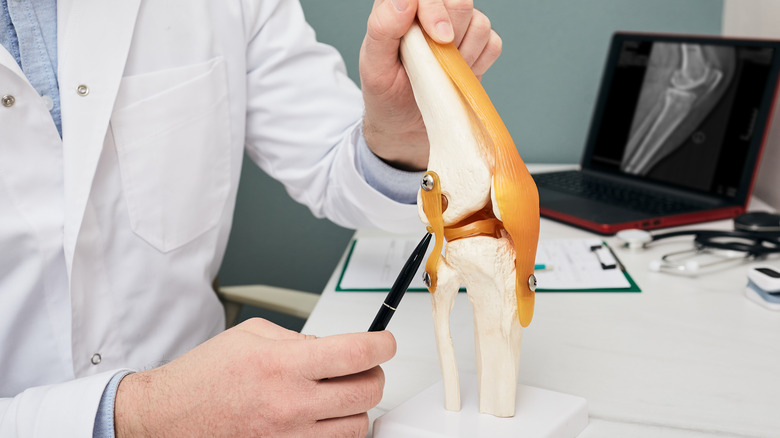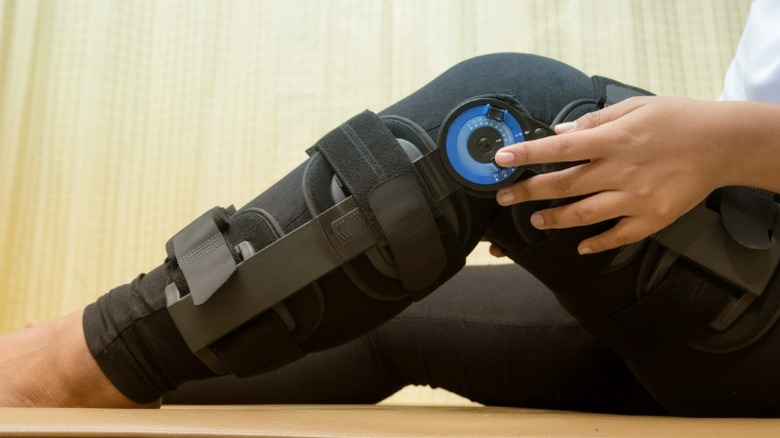An Orthopaedic Surgeon Shares What To Expect After ACL Surgery
If you play sports or even watch them, the last thing you want to hear or feel when an athlete's knee suddenly jerks is that dreadful "popping" noise. This sensation can occur when the anterior cruciate ligament, or ACL, is injured. In the immediate aftermath, the injured person may notice swelling in the knee, be unable to bear their normal weight load, and the knee may also feel unstable. ACL injuries are most likely to occur in sports where people often change direction quickly, like basketball, football, hockey, soccer, and even downhill skiing. A torn ACL often requires surgery to fully recover.
To understand what to expect after ACL surgery, Health Digest spoke with Kevin R. Stone, MD, Orthopaedic Surgeon at The Stone Clinic in San Francisco, Chairman of the Stone Research Foundation, Chairman at The Meniscus Transplant Study Group, Head of the Robotic Surgery Center at The Stone Clinic, and Member of the ACL Study Group — a leading collection of select surgeons from around the world specializing in ACL surgery, rehabilitation, and research.
The anterior cruciate ligament procedure
Dr. Stone explains that the goal of the ACL procedure is to provide stability back to the knee. "Repair of the ACL involves sewing back the torn fibers to the bone where it inserts," he states. "Reconstruction of the ACL involves replacing the torn tissue with a substitute either from the patient or from a donor called an allograft."
The first step of the procedure is to evaluate the torn tissue. "Most ACL injuries involve destruction of the inner fibers of the ligament and require replacement," Dr. Stone explains. "Here the surgeon must carefully identify the natural anatomic insertion sites, place tunnels there and then insert a graft."
The graft, Dr. Stone states, can come from either the patient's own body or from a donor — although a donor is typically the preferable option. "We prefer to not further injure the patient by a second site surgery and therefore almost always choose a donor quadriceps tendon graft with bone as it has been shown to be the strongest replacement tissue available." Dr. Stone notes, however, that some data suggests there is a higher re-rupture rate when using donor grafts on young athletes, but explains that, "we believe the damage caused by harvesting their own tissues is less than the risk of a repeat reconstruction."
Hospital time, emergency symptoms, and recovery
You do not need to worry about a hospital stay if you need ACL surgery. Dr. Stone notes that — in his clinic — the procedure is performed at the outpatient surgery center. But there are a few emergency symptoms to look out for. "As with any surgery, bleeding, blood clots, and infection are the problems we go to great lengths to avoid," says Dr. Stone. "Unusual pain, swelling, redness, shortness of breath, fever are the usual initial signs of a problem. Fortunately, due to the immediate weight bearing, on-site physical therapy and fitness training, daily supervision, and minimal surgical exposures; these problems are now rare."
As far as the recovery process goes, Dr. Stone states that it begins right away. "Our patients enter our rehab program the day of the injury and continue the day after surgery," he says. "Regaining immediate full range of motion is one key to a successful outcome. Helping the patient to see themselves as an athlete in training and not a patient in rehab has been critical to our success." For many, returning to sports can occur at six months, but some are advised to wait a year — depending on their individual fitness level. Dr. Stone also recommends a minimum of 4-6 months of rehabilitation exercises with a physical therapist and fitness coach.



